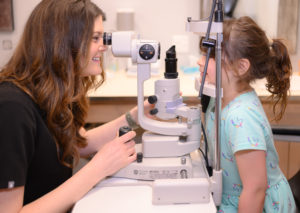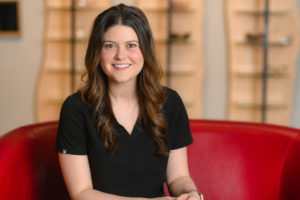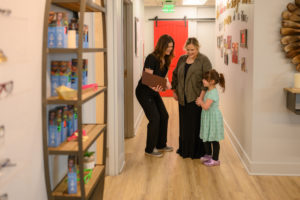November 15, 2022
By Kate McClure, OD, MS, FAAO
As an eye care practitioner in a quickly evolving field, it is important to stay active and up to date on all of the latest advancements, treatments, and technologies — especially for myopia management. I’m a big proponent of attending conferences, networking with colleagues, and learning from my peers.
My journey into the eye care field and myopia management began after I graduated from the Ohio State University College of Optometry in 2016. I stayed at Ohio State for two additional years to complete an Advanced Practice Fellowship in Cornea and Contact Lenses. During this time, I became interested in fitting patients with orthokeratology, which further sparked my interest in myopia management.
Myopia management was just beginning to become a specialty offered in some offices during my first few years in practice. We slowly started fitting myopic patients with OrthoK and soft lens multifocal contacts. With my background, I had more experience and interest in the contact lens aspect of myopia management. Our practice is unique because we have an entire office devoted to pediatric eye care, and I have partners who are very passionate about pediatric care. In time, they started to bring low-dose atropine therapy to our practice. We are fortunate to have a compounding pharmacy here in Columbus, Ohio, so we could also provide low-dose atropine as an option for our myopic patients. I would say that atropine was a little easier to implement than some of the other treatment modalities because it takes slightly less staff involvement and doctor chair time. Before starting any treatment in your office, you must set policies and procedures and educate staff appropriately.
Soon, we realized that we were providing many great options for our patients, and we worked to develop an official “myopia management clinic” in our offices. Since we provide care for so many children in the community, we saw the need to focus on myopia management.
Creating Myopia Management Treatment Plans
Each child we treat is different, so their treatment plans reflect that. We work to create a customized treatment plan for each child. However, the treatment only works if the parent and child are compliant. We have an in-depth conversation to ensure the treatment best suits the family and their needs. The conversation is also guided by interest or motivation for contact lenses. If the child is adamantly against contact lenses, OrthoK and soft multifocal lenses can create a tough road ahead. In that case, we will begin with low-dose atropine. We may base the conversation around those treatments if the parents and children are excited and intrigued by contact lenses. I like to take the time to get to know the families to help them choose the best treatment.

Dr. McClure likes to get to know her patients before deciding on a myopia management treatment plan.
While I don’t typically start with combination treatments, if we are not getting the intended results, I’ll have a discussion with patients and parents about adding a therapy or switching to a different therapy. Sometimes cost is a factor — all of the treatments are costly. Occasionally, I have patients who start with low-dose atropine, and then they eventually become interested in contact lenses. In this instance, often, we will continue the atropine for some time, and then I will give the option to discontinue it once the child has been successfully fit and is consistently wearing the contact lenses.
Communicating with Parents and Patients
There are always some hurdles when offering myopia management to patients. In our office, one of the biggest challenges has been learning to efficiently educate parents and patients on the importance of slowing myopia.

Dr. McClure works to educate patients and their parents about the importance of myopia management treatments.
Many contact lens companies provide helpful resources for patients and parents. Visioneering Technologies Inc. (VTI) and CooperVision have great patient resources and handouts to help explain myopia and contact lenses. Euclid Systems Corporation also has informative patient education tools. I encourage browsing the company’s website for resources if you use any contact lens products for myopia management. It can also be helpful to ask your local rep for any tools, as they can usually help provide educational handouts and resources for the office. The Brien Holden Vision Institute also has a Myopia Calculator that can help explain myopia progression and risk to parents. Over the last few years, the doctors in our practice have worked together to create our own myopia management pamphlet for our practice to help explain the treatments we provide, policies, and procedures.
Another challenge we experience in our practice is communicating with the patient’s parents about the cost of myopia treatment. We know myopia management is vital for our young myopes, but it can be expensive for many families. There are significant costs for all the treatments, and we need to charge appropriately for our chair time. The costs of the treatments can often be an uncomfortable conversation at first. We try to focus on the benefits of creating a customized plan for each patient.
Staying Active and Engaged in the Eye Care Field
As an eye care practitioner in a quickly evolving field, it is important to stay active and up to date on all of the latest advancements, treatments, and technologies — especially for myopia management. I’m a big proponent of attending conferences, networking with colleagues, and learning from my peers. I’m also a member of the Ohio Optometric Association, and talking with other ODs at local events can spark meaningful conversations.
I attend the Global Specialty Lens Symposium every year, and this is where I initially gained knowledge for fitting and managing OrthoK. I also attend the American Academy of Optometry meeting annually and get much of my information from the continuing education courses. The most recent Academy meeting had many great lectures on myopia management. Many contact lens companies will also provide training courses and literature to help get you started, as they want to help you succeed with their products. The Review of Myopia Management website is also an essential resource for the latest in myopia care.
I think we have only scratched the surface of myopia management. Over the next few years, more peer-reviewed studies will be published to help us make more informed choices for our patients.
 |
Dr. Kate A. McClure completed her Doctor of Optometry degree at The Ohio State University College of Optometry. She continued her education at Ohio State, earning a Master of Science degree in Vision Science while completing a two-year Advanced Practice Fellowship in Cornea and Contact Lens. Dr. McClure is currently part owner of a multi-location private practice in Columbus, Ohio, where she fits specialty contact lenses. She also has an interest in myopia management. Dr. McClure also serves on faculty at The Ohio State University College of Optometry as an Assistant Clinical Professor. |














